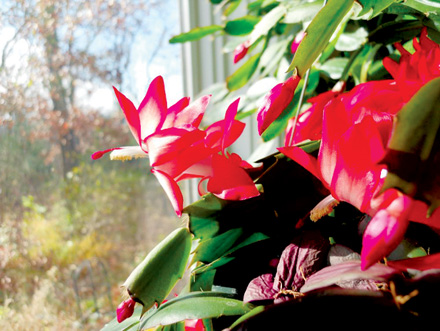Christmas and Thanksgiving Cactuses

GTD If I had to guess based on the stories people have shared with me, one out of every two homes in the area where I live have either a Thanksgiving or Christmas cactus. They can become like members of the family, passed down from one generation to the next with the same formality as the family silver.
One lady said she can track her Christmas cactus to her great-grandmother, which is very possible. These Brazilian plants were discovered in 1858 and have a complicated family tree. The bottom line is they were a popular house plant during the Victorian Era and have grown in popularity ever since.
When researching this plant’s history, I was intrigued to find out the original plants were native to Espirito Santo, the state where I grew up in Brazil. In their original habitat, they grow in tree crevices and rock out-croppings. I am sure we had these growing in our backyard mixed in with the orchids that grew off the side of trees.
These plants have been divided into two basic families:
Thanksgiving cactus (Schlumbergera truncata) is what is currently sold as Christmas cactus. Thanksgiving cactus have pointed, tooth-like notches on the margins of the green stems.
Christmas cacti (Schlumbergera bridgesii) have rounded notches on the margins of the stem segments. They look like someone came along and cut off the little stem-edged horns. If you have an older cactus or inherited one, those are more likely to be the old-fashioned Christmas cactus.
I keep mine in hanging pots in my basement for most of the year. It’s colder there and they naturally get the 12 hours a day that triggers setting bud. If you have yours in a better lit area, cover them with a dark cloth or put them in a closet every night to simulate those conditions starting in September.
If you don’t want to fuss with denying them light, expose the plant to temperatures between 55 and 60 degrees for 6 weeks until you start seeing flower buds forming. Also stop fertilizing and reduce watering.
Once flower buds set, return the plant to normal light conditions and resume watering. When in bloom, these plants should be watered about once a week or when the top half of the soil in the container becomes dry. Lack of water will cause the flower buds to drop. Buds will also drop because of excessive heat, too much light, cold drafts, sudden change in light and temperature and inadequate watering. Yes, they can be a little touchy.
If you want to get your plants bushier, give them a June haircut.
I don’t do much to mine except enjoy them when they are in bloom. So pretty.
Charlotte Ekker Wiggins is a certified gardener, beekeeper and sometimes cook. Copyright 2016 used with permission, all rights reserved. This material may not be published, broadcast, rewritten or redistributed. Contact Charlotte at chargardens@gmail.com.

LOOK FOR THE HORNS – The Christmas cactuses now available come in basically three colors: white, dark pink and red and are more correctly identified as Thanksgiving cactuses.

GOT HORNS? THANKSGIVING CACTUS – This is one of my favorite cactus colors, a rich Christmas red. Can you tell which one this is, a Christmas or Thanksgiving cactus? It’s a Thanksgiving cactus, see the little horns on the edge of the stems? (Photos by Charlotte Ekker Wiggins).



Facebook Comments